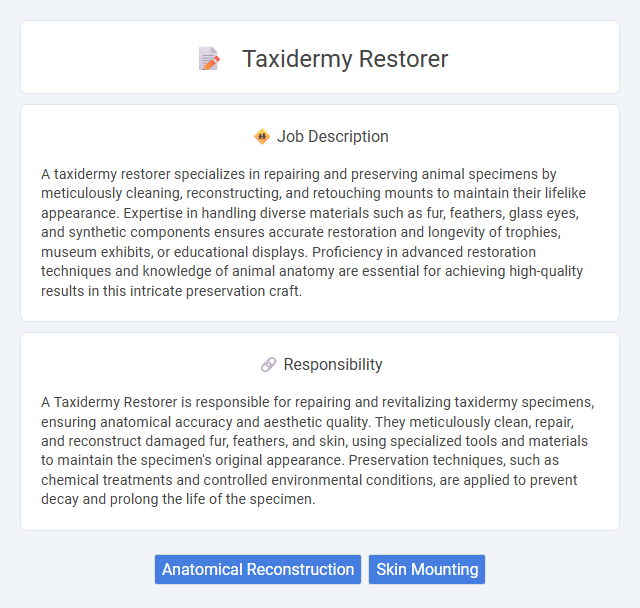
A taxidermy restorer specializes in repairing and preserving animal specimens by meticulously cleaning, reconstructing, and retouching mounts to maintain their lifelike appearance. Expertise in handling diverse materials such as fur, feathers, glass eyes, and synthetic components ensures accurate restoration and longevity of trophies, museum exhibits, or educational displays. Proficiency in advanced restoration techniques and knowledge of animal anatomy are essential for achieving high-quality results in this intricate preservation craft.
Individuals with strong attention to detail and patience are likely to be well-suited for a taxidermy restorer job, as the work requires precision and careful handling of delicate materials. Those who are comfortable working with animal specimens and have a steady hand might find this role aligns with their skills and interests. Conversely, people who experience discomfort around dead animals or have difficulty focusing on meticulous tasks may find this occupation less suitable.
Qualification
A taxidermy restorer requires expertise in anatomy, art, and chemistry to accurately repair and preserve animal specimens. Proficiency in sculpting, painting, and skinning techniques ensures the restoration maintains lifelike detail and durability. Formal training through specialized courses or apprenticeships, combined with a keen eye for detail and steady hand coordination, is essential for success in this role.
Responsibility
A Taxidermy Restorer is responsible for repairing and revitalizing taxidermy specimens, ensuring anatomical accuracy and aesthetic quality. They meticulously clean, repair, and reconstruct damaged fur, feathers, and skin, using specialized tools and materials to maintain the specimen's original appearance. Preservation techniques, such as chemical treatments and controlled environmental conditions, are applied to prevent decay and prolong the life of the specimen.
Benefit
A taxidermy restorer job likely offers the benefit of preserving valuable historical and natural artifacts, contributing to educational institutions and museums. This work may provide a unique opportunity to develop specialized skills in anatomy, artistic techniques, and material science. The role can also offer job satisfaction by combining art and science to bring longevity to important specimens.
Challenge
The role of a taxidermy restorer likely involves intricate challenges due to the delicate nature of preserving and repairing animal specimens. Restorers may frequently encounter deteriorated materials that require precise techniques to maintain authenticity and longevity. There is a probability that problem-solving skills are essential for addressing unpredictable damage while preserving historical and aesthetic value.
Career Advancement
Taxidermy restorers refine and preserve preserved animal specimens, enhancing their lifelike appearance for museums, educational institutions, and private collectors. Career advancement often involves gaining specialized skills in anatomical accuracy, advanced restoration techniques, and knowledge of diverse animal species, leading to positions as lead restorers or museum conservators. Professionals may also expand into teaching or consultancy roles, contributing expertise to exhibitions and conservation projects.
Key Terms
Anatomical Reconstruction
Taxidermy restorers specializing in anatomical reconstruction meticulously repair and rebuild animal specimens by accurately replicating skeletal and muscular structures. This role demands expertise in anatomy, advanced sculpting techniques, and the use of specialized materials to restore form and natural posture. Precision in tissue alignment and attention to detail ensure lifelike restoration, crucial for museum exhibits and educational displays.
Skin Mounting
A taxidermy restorer specializing in skin mounting expertly repairs and preserves animal skins for display and educational purposes. This role demands proficiency in handling delicate skins, applying tanning solutions, and reconstructing anatomical features to ensure lifelike appearances. Advanced knowledge of anatomical structures, preservation chemistry, and restoration techniques is essential for achieving accurate and durable mounts.
 kuljobs.com
kuljobs.com